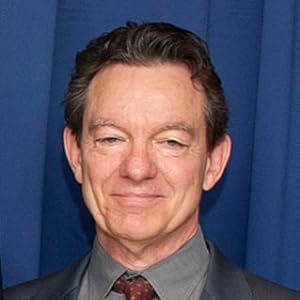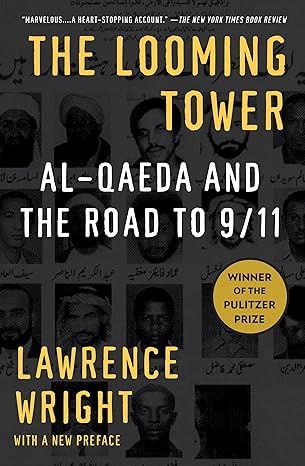
The Looming Tower: Al-Qaeda and the Road to 9/11
4.7 out of 5
4,119 global ratings
NATIONAL BESTSELLER • PULITZER PRIZE WINNER • A “heart-stopping account of the events leading up to 9/11” (The New York Times Book Review), this definitive history explains in gripping detail the growth of Islamic fundamentalism, the rise of al-Qaeda, and the intelligence failures that culminated in the attacks on the World Trade Center.
In gripping narrative that spans five decades, Lawrence Wright re-creates firsthand the transformation of Osama bin Laden and Ayman al-Zawahiri from incompetent and idealistic soldiers in Afghanistan to leaders of the most successful terrorist group in history. He follows FBI counterterrorism chief John O’Neill as he uncovers the emerging danger from al-Qaeda in the 1990s and struggles to track this new threat.
Packed with new information and a deep historical perspective, The Looming Tower is a sweeping, unprecedented history of the long road to September 11.
About the authors
Lawrence Wright
Lawrence Wright (born August 2, 1947) is a Pulitzer Prize-winning American author, screenwriter, staff writer for The New Yorker magazine, and fellow at the Center for Law and Security at the New York University School of Law. Wright is best known as the author of the 2006 nonfiction book The Looming Tower: Al-Qaeda and the Road to 9/11. Wright is also known for his work with documentarian Alex Gibney who directed film versions of Wright's one man show My Trip to Al-Qaeda and his book Going Clear.
Read more
Reviews
Thomas B. Roach
5
THE book to read if you ever want to know why 9/11 happened
Reviewed in the United States on July 23, 2008
Verified Purchase
I like to read a lot. I owned the hard copy version of The Looming Tower and because I have well over 500 other books on my shelves, hadn't gotten around to reading it. Then I downloaded the iPod audiobook version which ended up grasping me totally. Finally I bought a Kindle and The Looming Tower now resides there as well.
The book is an incredible story of 9/11 and those who made, and let it happen as well as those who tried as hard as they could to prevent it. One of the latter was an FBI agent who is as complex a character as full of flaws as a human can be but if there is a hero in this book, it's him -warts and all. He was killed on 9/11 trying to save people in the WTC.
Why is this book so good? Because it really delves into the mind set of those who made it happen from bin Laden and his henchmen, to a certifiable "nut case", a Sayyid Qutb whose repressed sexuality and heavens knows what else drove him to father the current version of Islamic fundamentalism. It's easy to realize what sort of sociopaths are drawn to this belief system, but America has its own nut case fundamental religious zealots be they Jewish or Protestant. They range from harmless "speaking in tongues" types and rattle snake handlers to "W", who is as motivated by religious fundamentalism as is bin Laden.
"W" has at least permitted and encouraged wiretapping and torture to deal with the violent brand of Arab crazies who wish a lot worse than 9/11 on us. It may seem out of line to those shuddering in horror at our loss of liberty, but so far there are no more 9/11s in the USA.
I was born in 1938 and remember WW2 [barely] but know enough history to know that when you are at war, you should spare no effort in totally destroying the enemy as we did in WW2 with the Japanese and Germans.
After spending 20 years in the military, I only became more convinced that war should occur only if you mean business. Bringing "democracy" to Iraq is a sick joke. "W" should have watched Lawrence of Arabia and maybe he might have gotten a clue of the inevitable morass that awaited those stuck in the tar of Iraq. In WW2 we weren't worried about locking up presumably innocent Japanese, or censorship of all letters from our soldiers. All this under a president who many Americans considered the political equivalent of Stalin, or the equivalent of a socialist's greatest hope. Today the liberals are still worrying about the loss of freedoms, but freedoms can return AFTER the war. Whether they will is another story. The fault with our current miasma of political manure lies with us citizens. What we see in Congress, not to mention the executive and judicial branches merely reflect America's citizens own lack of care, education and hedonism.
But I digress. The Looming Tower is an incredible "morality tale" and Greek tragedy wrapped up in one. Hubris abounds, those idiots responsible for the debacle are named, although it is apparent that none suffered career reversals for their poor performance with the exception of the two people who saw it coming and couldn't stop it - FBI agent O'Neill and Richard Clarke. Clarke was smeared by Bush gunsels from Limbaugh to other White House staff thugs who fear the truth as a vampire fears sunlight. Condoleza Rice is shown as witless and also very much responsible for 9/11 because when presented with reality she couldn't think clearly or was driven by political expediency to the wrong decision - i.e. ignoring the threat.
The book is NOT a hatchet job on anybody. You get to see all the characters responsible on both sides and there is little to no judgmental criticism. As Det. Friday used to say on Dragnet, for those of you ancient enough to remember him, "Just the facts, M'am. Just the facts."
Much as I hate to swallow my atavistic tendencies to dismiss the likes of bin Laden and his cronies as crazy "rag heads", you will understand the character attributes that made his hellish plans come to fruition, and they certainly did not start with 9/11. I can only wish we had the likes of him to conduct our own war on the terrorists, although fortunately Cheney comes close.
Read this book. You can only grow wiser and sadder from the experience.
Read more
4 people found this helpful
-_Tim_-
5
The Looming Tower
Reviewed in the United States on February 5, 2010
Verified Purchase
The Looming Tower, by Lawrence Wright, traces the history of Al-Qaeda from its roots in Egypt and Saudi Arabia to Afghanistan and Pakistan and finally to the 9/11 attacks on the World Trade Center and the Pentagon.
Wright's narrative begins in Egypt, where the humiliation of the Arab states in the 1948 war and popular disgust with King Faisal helped build support for Islamic fundamentalists. There, the Muslim Brotherhood, using a structure of secret cells with no more than five members each, built a powerful political, economic, and social force. However, Egypt's geography did not favor guerilla warfare, and Egypt's secular governments brought force to bear to suppress the Brotherhood and other radical Islamic movements.
In Saudi Arabia, the intolerant Wahhabi sect was "a dam against the overwhelming, raging river of modernity" that accompanied exploitation of the country's oil resources. According to Wright, radical fundamentalism was also a reaction against royal ostentation and displays of wealth. The collapse of oil prices in the 1980s accentuated stresses within Saudi Arabia. According to Wright: "Radicalism usually prospers in the gap between rising expectations and declining opportunities. This is especially true where the population is young, idle, and bored; where the art is impoverished; where entertainment - movies, theater, music - is policed or absent altogether; and where young men are set apart from the consoling and socializing presence of women."
In 1979, a Palestinian cleric named Abdullah Azzam issued a fatwa against the Soviets and helped convince 3,000 Arabs to move to Peshawar, Pakistan where they expected to support the Afghan mujahideen. His emphasis on martyrdom "created the death cult that would one day form the core of al-Qaeda." While this force had no practical impact in the conflict with the Soviets - Wright says most members never left Peshawar - Osama bin Laden was able to exploit a "David and Goliath" myth to enhance his prestige.
Bin Laden split from Azzam in 1990 to form al-Qaeda, and he returned to Saudi Arabia a hero. Expelled for his criticism of Saudi cooperation with the United States after Iraq's invasion of Kuwait, he moved to Sudan. There, he enjoyed a bucolic life until 1996, when the United States pressured Sudan's government to expel him. By now, the Saudi government had confiscated bin Laden's share of his family's construction business, and Sudan's government confiscated nearly all of his remaining wealth when he was forced to leave Sudan. Hereafter, bin Laden would be dependent on external financing to keep al-Qaeda in operation.
In Afghanistan again, bin Laden set up camps that, according to Wright, trained 10 to 20 thousand Sunni fighters. These were not the dreamers and posers that came to Peshawar in the 1980s. These were educated men who had lived in Europe or the United States and spoke several languages. Many of them were not very religious before joining al-Qaeda.
The United States focused on bin Laden and al-Qaeda as an unambiguous threat after the embassy bombings in Kenya and Tanzania in 1998. But, according to Wright, U.S. intelligence and military forces were not well prepared to respond to this type of unconventional threat. In retaliation for the bombings, the United States fired $750 million worth of cruise missiles at a pharmaceutical plant in Sudan and at bin Laden's camps in Afghanistan, but only a handful of al-Qaeda members were killed.
At this point, bin Laden and his organization were a liability to the Taliban. It was not in the Taliban's interests to allow bin Laden to turn the United States into an enemy by planning and launching attacks from Afghanistan. In fact, Wright says, Mullah Omar had already reached an agreement in principle to turn bin Laden over to the Saudi government. But these considerations were discarded when bin Laden pledged his "personal fealty" to Mullah Omar and recognized his authority as his "noble emir." From this point onward, a friendship developed between the men and Mullah Omar defended bin Laden against complaints by other members of the Taliban.
Wright's book ends with an account of the 9/11 attacks themselves, focusing on John O'Neill, a former FBI agent who became the World Trade Center's security chief just a few days before the attacks. Wright's account of the attacks is deeply disturbing and includes details that other writers have omitted, possibly from a sense of delicacy. It is best written account I have seen.
Wright is critical of poor communication within the U.S. intelligence and law enforcement communities on al-Qaeda's intentions. He attributes this poor communication not to legal obstacles, but to a fear that arrests and prosecutions would allow al-Qaeda to learn too much about U.S. intelligence gathering activities.
The Looming Tower has three principal strengths that distinguish it from similar histories. First, Wright includes enough information about his principal characters to make them three-dimensional: bin Laden is not just an evil plotter, he is also "the most daring terrorist in history" and his "commitment and relentlessness" are "unequaled." O'Neill is not just an indefatigable FBI agent locked in a contest with bin Laden, he is also a deceitful womanizer who runs up large debts. Second, Wright is careful with his evidence and discloses its limitations. Third and finally, Wright can write. The narrative rushes along, pulling the reader through the book to its final, violent denouement.
Read more
6 people found this helpful
Tom Weikert
5
Captivating!
Reviewed in the United States on May 27, 2009
Verified Purchase
Well-researched and based on a carefully constructed timeline, The Looming Tower reveals facts about the rise of al-Qaeda and the 9/11 attacks that most readers will find surprising. For instance, a common misconception is that Osama Bin Laden was wealthy and therefore able to self-fund the training and equipping of al-Qaeda fighters. In Lawrence Wright's account, we learn instead that while certainly wealthy, Bin Laden's strength is as a prolific fundraiser. He is able to tap both wealthy Arab governments and private donors, particularly as he demonstrates al-Qaeda's increasing lethality. Much more significant perhaps, Wright portrays Bin Laden as a master of public relations. Indeed, he demonstrates early on that his charisma and soft-spoken charm could both inspire followers and unleash horrific violence.
In the lead up to 9/11 Bin Laden captures the imagination of disaffected but well-educated young Muslim males searching for validation and a deeper meaning in their lives. Already steeped in traditional Muslim thought (many studied in madrasses in Western Pakistan), these individuals merely need a catalyst and some direction for their aims and readily find it in Bin Laden's radical proselytizing. Proving Josef Goebbels' famous quote, "make the lie big, make it simple, keep saying it, and eventually they will believe it", Bin Laden convinces his followers that America (and its staunch ally, Israel) is the source of all persecution in the Islamic world. He eventually gains a critical mass of converts and hence a blunt instrument to wage global jihad.
The scheme to strike at the soft underbelly of American 'infidel' society and the means to do it are born.
Wright also exposes the many seams in the U.S. national security infrastructure and schisms within the law enforcement and intelligence organizations that existed prior to 9/11. Ironically, those same intelligence organizations were created with the single purpose of detecting and preventing terrorist attacks. Simply tragic...
The mosaics the author pieces together in developing his characters (based on scores of interviews) bring to life such leading U.S. counterterrorism officials as Richard A. Clarke and John P. O'Neill. These individuals' relentless efforts to protect America's domestic and international interests undoubtedly prevent countless attacks. Yet, as Wright alludes, their persistent demands to go on the offense against an emergent al-Qaeda are stymied by poor communication and internecine rivalries between government agencies combined with bureaucratic inertia and simple inaction on the part of our country's political leaders.
The Looming Tower traces the roots of al-Qaeda to radical Islamic organizations such as Egyptian Islamic Jihad and the Muslim Brotherhood and fiery Islamic scholars like Sayyid Qutb and Dr. Abdullah Yusuf Azzam. We learn that while their extreme views prove a source of discomfort for mainstream Islamic governments - they espouse violent uprising to achieve their ends - their aggressive activism is largely contained. Interestingly, despite Azzam's pleas for moderation, Bin Laden exhorts his charges to commit suicide bombings as a means of achieving al-Qaeda's aims (and those of greater Islam) while punishing America for 'occupying' the Arabian Peninsula.
Additionally, we discover that Ayman al-Zawahiri and Bin Laden find refuge and a sympathetic ear in failed states such as Somalia, Sudan, and Afghanistan and co-opt their governments to help nurture and train radicals for jihad. Their demands ever more insistent and their attacks growing in ferocity, Islamic extremists in the Bin Laden era gain a new sense of urgency. Yet, incredibly, despite many alarm bells Western intelligence agencies remain unable to convince their governments of the seriousness of the threat posed by al-Qaeda.
Wright pieces together through hundreds of interviews each militant Islamist plot from the 1993 World Trade Center bombing through the 2000 USS Cole suicide attack. He painstakingly traces the steps of the jihadists as they gradually ratchet up the stakes while leaving unmistakable clues as to their grand design. Only a handful of astute, hyper-vigilant FBI and CIA agents grasp the significance of those clues, but their voices are seemingly drowned out by the bureaucracy with, of course, calamitous results.
The Looming Tower ranks with Rohan Gunaratna's Inside Al Qaeda and Steve Coll's Ghost Wars in its narrative sweep. Not nearly as dense as the Pulitzer Prize-Winning Ghost Wars, The Looming Tower combines the right amount of detail with the author's lighter prose style. Wright manages to entertain as much as he informs. Perhaps most enjoyable about Wright's book, it details unusual aspects of his characters' personalities that make them seem more human. Bin Laden, the devoted family man; John O'Neill, the sentimental romantic; and, Richard Clarke, the ambitious product of blue collar roots... These are the figures who grace Wright's pages. And a truly fascinating cast of characters it is!
Lawrence Wright's book, though a work of investigative journalism, reads like a Greek tragedy.
A sobering insider's look at the first (and arguably most) serious threat facing the West in the 21st Century and an immensely satisfying read...
Captivating!
Read more
11 people found this helpful
dmiguer
5
A Road to Ruin
Reviewed in the United States on June 11, 2020
Verified Purchase
"Wherever you are, death will find you, even if you are in high towers." - Quran 4:78
Sayyid Qutb, an Egyptian Islamic theorist, begins this saga with a voyage to the US in 1948. After a brief stay in the post war sin city of New York, Qutb attended college in small town Colorado as a well known Arabic author. On return to Cairo his ideas crystallized into a dialectical opposition between east-west, traditional-modern and religious-secular. At the time Israel had defeated the Arab alliance and the British were occupying the Suez Canal. Joining with the Muslim Brotherhood, Qutb assisted Nasser in 1952 to depose King Farouk, but Pan-Arabic socialism thwarted his desires for a sharia state. Following a 1954 assassination attempt on Nasser, Qutb was jailed and then executed in 1966.
Ayman al-Zawahiri was born in 1951 to a famous family of doctors and clerics, friends of Qutb. He lived in a rich Cairo suburb, home to Edward Said, Omar Sharif and future King Hussein. In 1967 Egypt blocked the straight to the Red Sea from Palestine. Israel destroyed Egypt's air force, overran Sinai and reached the Suez canal in less than a week. The same six days saw the capture of Jerusalem, the West Bank, Golan Heights, and a rout of Jordanian and Syrian forces. The war marked the birth of a new fundamentalism. Only a return to the faith could regain the lost favor of God. Zawahiri believed that restoration of a caliphate would lead to a holy war with the US and it's Jewish conspirators.
Nasser died in 1970 and Sadat emptied jails of Muslim Brothers in a bid to legitimize his presidency. The decade saw a surge in radical groups fostered by official tolerance. Khomeini established Islamic rule in 1979 Iran, raising hopes for theocracy. Egypt was not ready for revolution however, and in 1980 Zawahiri visited Pakistan to provide medical support in the Afghanistan conflict. Sadat had signed a treaty with Israel in 1978, and was assassinated in 1981. Zawahiri was implicated, and tortured in the Citadel of Cairo. Mubarak arrested hundreds of Islamists for the trial. Omar Abdel Rahman, leader of the 1993 World Trade Center bombing would share prison time with Zawahiri.
Osama bin Laden was born in 1957 to a successful family of developers in Saudi Arabia. King Saud had ended a rebellion of religious fanatics in 1931, and established Salafism as the fundamentalist creed of the land. Oil boomed in 1950, and the bin Laden's became rich through construction for the king. Seventeenth son Osama was a devout youth, and fervent for sharia law. Influenced by Qutb, he joined the Muslim Brothers. Rapid social change and resentment of royalty spurred dreams of revolution. King Faisal was killed in 1975 while making secular reforms. Mecca's mosque was seized in 1979 by rebels seeking theocratic rule. If an Islamic state could be formed the world would soon follow.
Abdullah Azzam, al-Azhar scholar and jihadi, left Jordan for Jeddah in 1980, where he met bin Laden. He joined Afghan forces against the Soviets, issued fatwas to fight and spun tales of battlefield miracles. Bin Laden had raised funds and recruited volunteers, where he met Zawahiri. Saudi royals sacrificed riches to defend the faith and block the USSR from the gulf. The US funneled fortunes into the region to protect oil interests. Bin Laden built training camps for foreign fighters, using Pakistan as a local base. A network of Arab princes, holy warriors, secret agents, Muslim mystics and puppet dictators was born. Azzam became a founding father of al-Qaida, Hamas and Lashkar-e-Taiba.
Azzam vied with Zawahiri and bin Laden for control of al-Qaida when the USSR fell in 1989. The Saudis intervened and bin Laden won the day. When Azzam fell from favor he was killed. Hailed as hero in the Afghanistan-Soviet war, bin Laden led a ragtag band who amused the Afghan army. The last half of the book covers the decade leading to the 2001 attacks. Royal corruption and an economic slide bred unrest in the Kingdom. Bin Laden blamed the US, a tricky position towards an ally against the USSR, but the princes feared domestic threats as much as foreign ones. Allowing infidel troops on Saudi soil in 1990 to attack Saddam Hussein was an affront to bin Laden, even in defense of Saudi oil.
Hasan al-Turabi, a Sudanese scholar armed with degrees from London and Paris, staged a coup that created a Sunni Islamist state in 1989. He had been a Muslim Brotherhood leader since 1964. Sudan opened it's doors to stateless jihadi, with a special invitation extended to bin Laden. Relocating to Khartoum in 1992 he reunited with Zawahiri. As the communist threat subsided a Christian one took hold. The presence of Americans in the KSA and Yemen violated a Quranic verse about one religion in Arabia. This coalesced into a crusades redux, where ancient battles began anew. If a western new world order was the future, then al-Qaida would reignite a fight for past traditions of law and faith.
Omar Abdel Rahman led the 1993 WTC bombing, funded by bin Laden. Al-Qaida trained fighters killed 19 US soldiers in Mogadishu that year. Mubarak survived a 1995 assassination attempt by Zawahiri. Bin Laden returned to Afghanistan in 1996, under the baleful eye of Taliban leader Mullah Omar, who was bankrolled by Pakistan and the KSA. Khaled Sheikh Mohammed visited bin Laden. His nephew, WTC bomber Ramzi Yousef blew up a passenger jet and plotted to kill Bill Clinton. Their new plan was to crash airliners into US buildings. Khobar Towers exploded, killing 19 US Air Force personnel. In 1997 62 tourists were gunned down in Egypt. Embassy bombings in Kenya and Tanzania followed in 1998.
The last quarter of the book details the dysfunctional ties between the FBI and the CIA. An agent of Zawahiri told the FBI about al-Qaida in 1993, but the CIA wasn't informed. As bin Laden declared war on the US in 1996 we wondered what it would mean. Al-Qaida began suicide missions, evolving from freedom fighters to global terrorists. In 1999 a missile strike aimed at bin Laden was canceled by the CIA. As al-Qaida pilots entered the US in 2000 the CIA didn't tell the FBI. The USS Cole exploded in Yemen killing 17 sailors. By the summer of 2001 there were reports a vast attack was imminent. The FBI agent who lead the al-Qaida team retired. Within two weeks at his new job in the WTC the planes hit.
I lived next to the WTC then as I do now. Assuming I had heard it all in the news, I delayed reading this book. Instead of a narrow focus on the 911 plot, the book gives a wide historical context. It is not a painstaking recount of the attack. Lawrence Wright won a 2007 Pullitzer Prize for his work. More than 350 people worldwide were interviewed by the author. He takes a balanced view and no one is blameless in this account. From blinkered politicians and warlike empires, corrupt royalty and cynical clergy, Machiavellian intellects and credulous minds came a scourge of violence. Bin Laden may not have succeeded in a showdown for a single world faith, but the seeds of destruction were sown.
Read more
27 people found this helpful
Michelle W.
4
“Wherever you are, death will find you, even in the looming tower.” — Quran 4:78
Reviewed in the United States on January 21, 2017
Verified Purchase
This is a thoroughly researched book that describes the family background, recent history, and influences on Osama bin Laden, the beginning of al-Qaeda, and the events that led to the attacks of September 11, 2001. This book took me so long to read because it is so chock-full of information and threads of events I either didn’t know about, or didn’t realize were connected, I ended up buying a used copy once I started reading my library check-out, just so I could highlight passages that were critical to understanding (I also needed to buy another highlighter when my first one ran out of ink), so this kind of slowed me down a bit. Since there are so many names of people involved, many with similar names, or people who disappear only to pop up again sometime later, I was very grateful for the detailed playlist of principle characters provided, in addition to a map of the region, an index, and a bibliography.
The author describes bin Laden’s father, Mohammed bin Laden, a wealthy and well-connected man responsible for building a ramp to the Royal palace and a previously unattainable road over the al-Sarawat Range, which united the Kingdom of Saudi Arabia, thus garnering favor with the Royal family, who subsequently appointed him honorary minister of public works. His growing reputation and Royal connections allowed for him to expand his businesses throughout the country, and at a time of financial difficulty, he loaned a substantial amount of money to the Royal family when the banks would not, further solidifying his relationship with the Royals.
Growing up in this privileged life, his 17th son, Osama bin Laden, also enjoyed a close relationship with the Royal family. Since he was further down the ladder in the order of sons, there were no positions of power within his father’s companies for him to assume, so he was left to “make his own way”. Of course, he was also provided a monthly stipend, so he never actually had a job, and this would be his primary source of income and how he financed his terrorist organization for much of his life. Surprisingly, he comes across as rather aimless and ineffective, lacking ambition or his father’s keen business sense. Without his father’s money to support him and his endeavors, it seems to me he would have become an unknown farmer, pontificating to his wives, children, and neighbors about the presence of Americans in the Middle East. It is only due to his father’s money and his willingness to spend it on the disillusioned masses that he found an audience for his disgruntled rantings and financially supported their destructive, rage-fueled fantasies of Islamic dominance.
While the book initially includes various events that occurred overseas, the author points out that bin Laden hadn’t really done anything at that point, and the events he publicly took credit for were events he had little to nothing to do with, so for some time, his reputation was being built on exaggerations or flat-out lies. His organization did continue to grow, but ignoring the aid of hindsight, there truly does not appear to the average reader to be a connection to the US that was overlooked by the authorities. There were, however, a handful of fastidious US intelligence agents who monitored bin Laden and those he financed throughout the 1990s, and they did see connections, but when they alerted others to the potential dangers posed by the largesse of this largely unknown man, without a direct or specific threat to the US, they were ignored. This error was further compounded by the folly of American bureaucracy and the unwillingness of the FBI, CIA, and NSA to work together and share information, which resulted in several missed opportunities. This is what I believe to be the crux of the “road to 9/11”: our intelligence agencies provided the unobstructed path with their lack of communication and teamwork. If each agency had not been so busy trying to keep any information they had away from the other agencies, they would have realized that they each possessed pieces of information that, when fit together, would have provided them with a better idea of what was going on, and could have led to the capture of key al-Qaeda members that would have thwarted their plans. Instead, their continued secrecy and stubbornness allowed known al-Qaeda members to enter the US and without hindrance, they were free to develop their plans.
On another disconcerting note, the author also points out that bin Laden knew he could not win a fight with Americans on US soil, and sought to devise a plan that would bring the fight to him, on “a large-scale front which it cannot control”, where American soldiers “cannot stand against warriors of faith who do not fear death”. Since Islamic extremists believe that jihad never ends, they would have generations of radical, resentful, and repressed Muslims, mesmerized by the myth of martyrdom, to fight the “eternal war” to defend Islam. We played right into his hands, waging war on their soil, where we have been for well over a decade now, without an exit strategy or an end in sight.
The author has done a fantastic job of writing a comprehensive history that creates a broader picture for the average reader to get a better understanding of how events that occurred a continent away would have rippling effects here in the US years later. This should be required reading for all.
Read more
24 people found this helpful
Best Sellers

The Great Alone: A Novel
4.6
-
152,447
$5.49

The Four Winds
4.6
-
156,242
$9.99

Winter Garden
4.6
-
72,838
$7.37

The Nightingale: A Novel
4.7
-
309,637
$8.61

Steve Jobs
4.7
-
24,596
$1.78

Iron Flame (The Empyrean, 2)
4.6
-
164,732
$14.99

A Court of Thorns and Roses Paperback Box Set (5 books) (A Court of Thorns and Roses, 9)
4.8
-
26,559
$37.99

Pretty Girls: A Novel
4.3
-
88,539
$3.67
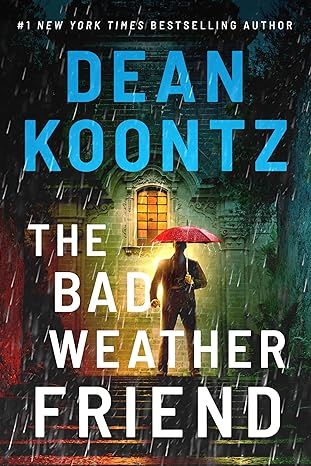
The Bad Weather Friend
4.1
-
34,750
$12.78

Pucking Around: A Why Choose Hockey Romance (Jacksonville Rays Hockey)
4.3
-
41,599
$14.84
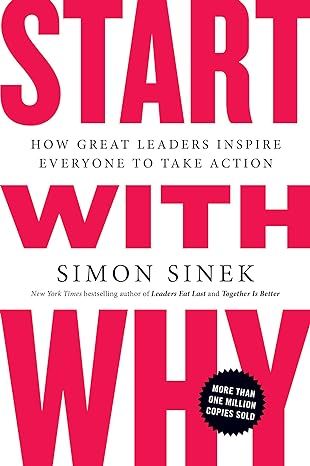
Start with Why: How Great Leaders Inspire Everyone to Take Action
4.6
-
37,152
$9.99
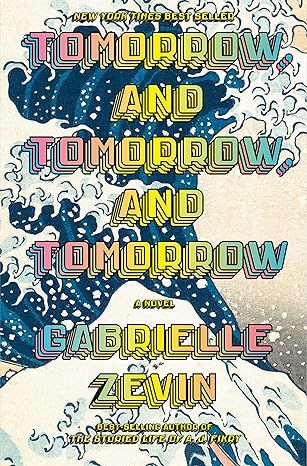
Tomorrow, and Tomorrow, and Tomorrow: A novel
4.4
-
95,875
$13.99
